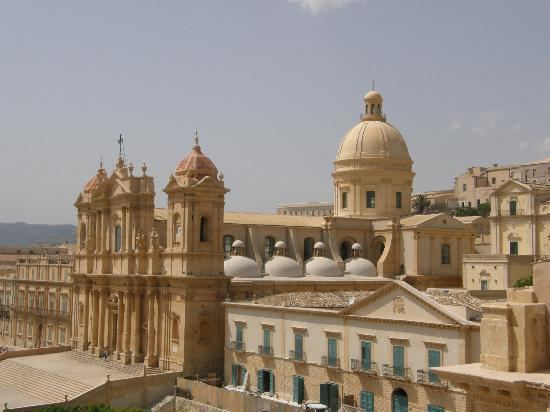Province / Metropolitan city Siracusa (SR) Elevation 152 m (499 ft) Area 550.9 km² | Frazioni see list Demonym(s) Notinesi or Netini | |
 | ||
Weather 13°C, Wind W at 10 km/h, 60% Humidity Points of interest Noto Cathedral, Nicolaci Palace, Palazzo Ducezio, Chiesa di Santa Chiara, Church of San Domenico | ||
Noto (Sicilian: Notu; Latin: Netum) is a city and comune in the Province of Syracuse, Sicily, Italy. It is 32 kilometres (20 mi) southwest of the city of Syracuse at the foot of the Iblean Mountains. It lends its name to the surrounding area Val di Noto. In 2002 Noto and its church were declared a UNESCO World Heritage Site.
Contents
- Map of 96017 Noto Syracuse Italy
- History
- Main sights
- Palaces and other buildings
- Religious buildings
- Archaeological finds
- Culture
- Frazioni
- Economy
- Quote
- References
Map of 96017 Noto Syracuse, Italy
History
The old town, Noto Antica, lies 8 kilometres (5 mi) directly north on Mount Alveria. A city of Sicel origin, it was known as Netum in ancient times. In 263 BC the city was granted to Hiero II by the Romans. According to legend, Daedalus stayed in the city after his flight over the Ionian Sea, as did Hercules after his seventh task. During the Roman era, it opposed the magistrate Verres.
In 866 it was conquered by the Arabs, who elevated the city to become a capital of one of the three districts of the island (the Val di Noto). In 1091, it became the last Islamic stronghold in Sicily to fall to the Christians. Later it became a rich Norman city.
In the 16th and 17th centuries, the city was home to several notable intellectual figures, including Giovanni Aurispa, jurists Andrea Barbazio and Antonio Corsetto, as well as architect Matteo Carnelivari and composer Mario Capuana. In 1503 king Ferdinand III granted it the title of civitas ingeniosa ("Ingenious City"). In the following centuries, the city expanded, growing beyond its medieval limits, and new buildings, churches and convents were built. These, however, were all totally destroyed by the 1693 Sicilian earthquake.
The current town, rebuilt after the earthquake on the left bank of River Asinaro, was planned on a grid system by Giovanni Battista Landolina. The new city occupied a position nearer to the Ionian Sea. The hiring of architects like Rosario Gagliardi, Francesco Sortino and others to rebuild the city helped make the new Noto a masterpiece of Sicilian Baroque, dubbed the "Stone Garden" by Cesare Brandi and is currently listed among UNESCO's World Heritage Sites. Many of the newer structures are built of a soft tufa stone, which assume a honey tonality under sunlight. Parts of the cathedral suddenly collapsed in 1996, a great loss to Sicilian Baroque architecture.
The city, which had lost its provincial capital status in 1817, rebelled against the House of Bourbon on 16 May 1860, leaving its gates open to Giuseppe Garibaldi and his expedition. Five months later, on 21 October, a plebiscite sealed the annexation of Noto to Piedmont.
In 1844, Noto was named a Diocese, but in 1866 suffered the abolition of the religious guilds, which had been deeply linked to the city's structures and buildings.
Noto was freed from the fascist dictatorship of Benito Mussolini in July 1943. The Notinesi people voted in favour of the monarchy in the referendum of 1946.
Main sights
Noto is famous for its fine buildings of the early 18th century, many of which are considered to be among the finest examples of Sicilian baroque style. It is a place of many religious buildings and several palaces.
Palaces and other buildings
Religious buildings
Archaeological finds
The remains of Noto's early inhabitants are almost entirely hidden beneath the ruins of the mediaeval town, except for three chambers cut into the rock. One is noted by an inscription in the library at Noto to have belonged to a gymnasium, while the other two were heroa (shrines of heroes). Explorations have discovered four cemeteries dating to the third Sicel period and one from the Greek period. Among other finds are catacombs of the Christian period and several Byzantine tombs.
About 6 kilometres (4 mi) south of Noto, on the left bank of the Tellaro (Helorus) river, stands a stone column about 10 metres (33 ft) high, which is believed to be a memorial to the surrender of Nicias. In the 3rd century BC, a tomb was excavated in the rectangular area which surrounds it, destroying an apparently pre-existing tomb. Remnants of a later burial site belonging to the necropolis of the small town of Helorus, 750 metres (2,460 ft) to the southeast, have been discovered. The Villa Romana del Tellaro is a Roman villa located south of Noto.
Culture
In the Noto neighbourhood, a 32-m radiotelescope was installed by the Istituto di Radioastronomia di Bologna as part of the Consiglio Nazionale delle Ricerche. It works in collaboration with a similar instrument in Medicina, Bologna.
The city has held an annual flower festival, the Infiorata, every May since the 1980s, lining the Corrado Nicolaci with floral mosaics.
Frazioni
Baulì, Buonivini (meaning "good wines"), Calabernardo, Castelluccio, Cipolla, Coda di Lupo, Falconara, Fondo Morte, Lenzavacche, Lido di Noto, Madonna Marina, Pantano Longarini, Pietà San Giovannello, Reitani, Rigolizia, San Corrado di Fuori, San Lorenzo, San Marco, San Paolo, Santa Lucia, Serra di Vento, Testa dell'Acqua, Vendicari and Villa Vela.
Economy
The local area is home to several quality wine producers.
Quote
Noto is one of the most beautifully-built towns in Europe and this remote little place comes out in the memory like Würzburg or Nymphenburg as one of the most [word missing] achievements of the age which produced Mozart and Tiepolo
